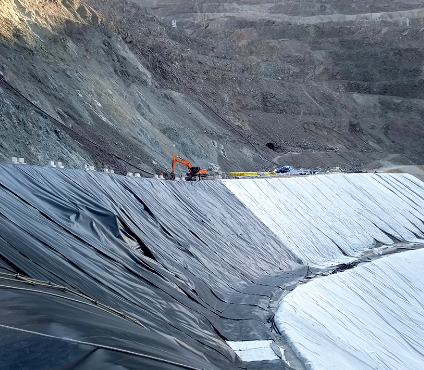- Understanding the Role of Geomembrane Liners in Waste Management
- Innovations in Geomembrane Liners for Water Management
- Geomembrane Liners: A Comprehensive Guide
- The Future of Geomembrane Liners in Civil Engineering
- Geomembrane Liners: Enhancing Landfill Stability
Manager:Alvin Wang
WhatsApp:+62 8983806051
Tel:+86 10-5797-1075
Email:steelwang@okorder.com
Address:3rd Floor, No.2 Building, No.1 Sanlihe Road
How thick is a geomembrane?
Geomembranes play a vital role in various engineering and environmental applications, serving as impermeable barriers to contain liquids and gases. Among the different types available, composite geomembranes and high-density polyethylene (HDPE) geomembranes stand out for their durability and versatility. But how thick should a geomembrane be to effectively fulfill its purpose? Let's delve into the intricacies of geomembrane thickness and its significance in different applications.

Understanding Composite Geomembranes
Composite geomembranes combine different materials to enhance their performance and durability. Typically, a composite geomembrane consists of layers of geotextile fabric and a geomembrane liner. The geotextile acts as a protective barrier, shielding the geomembrane from punctures and abrasions while providing additional reinforcement.
When determining the thickness of a composite geomembrane, engineers consider factors such as the type of project, environmental conditions, and the level of protection required. For applications where puncture resistance is crucial, a thicker geomembrane combined with a robust geotextile fabric provides superior performance and longevity.
In containment projects such as landfills, reservoirs, and mining operations, composite geomembranes with thicker liners are often preferred to withstand the harsh conditions and prevent leakage of contaminants into the surrounding soil and groundwater.
The Role of hdpe Geomembranes
HDPE geomembranes are renowned for their exceptional strength, chemical resistance, and flexibility. Made from high-density polyethylene resin, these geomembranes offer superior performance in various applications, including pond liners, waste containment, and secondary containment systems.
The thickness of an HDPE geomembrane depends on the specific requirements of the project and the level of protection needed. In applications where exposure to chemicals or harsh weather conditions is a concern, a thicker geomembrane provides added resilience against degradation and permeation.
HDPE geomembranes are available in a range of thicknesses, typically measured in mils or millimeters. Thicker geomembranes offer greater puncture resistance and tensile strength, making them suitable for demanding applications such as primary and secondary containment in industrial facilities and hazardous waste sites.
Factors Influencing Geomembrane Thickness
Several factors influence the determination of geomembrane thickness for a particular project:
1. Environmental Conditions: The climate, temperature variations, and exposure to UV radiation can affect the performance and longevity of a geomembrane. In regions with extreme weather conditions, thicker geomembranes with UV stabilizers are recommended to withstand degradation and maintain their integrity over time.
2. Substrate Characteristics: The nature of the underlying soil or substrate plays a crucial role in determining geomembrane thickness. In areas with sharp rocks, abrasive soil, or high groundwater pressure, thicker geomembranes provide enhanced protection against punctures and tears.
3. Hydraulic Conditions: Projects involving containment of liquids or gases require geomembranes with sufficient thickness to withstand hydrostatic pressure and prevent leakage. Thicker geomembranes with high puncture resistance are essential for ensuring the integrity of containment structures such as reservoirs, ponds, and lagoons.
4. Regulatory Requirements: Regulatory agencies may specify minimum thickness requirements for geomembranes used in environmental containment projects to ensure compliance with safety and environmental standards. Adhering to these requirements is crucial to avoid regulatory penalties and ensure the long-term effectiveness of containment systems.
Optimizing Geomembrane Thickness
Selecting the appropriate thickness for a geomembrane involves a careful assessment of project-specific factors and performance requirements. While thicker geomembranes offer greater durability and protection, they also come with increased material and installation costs. Therefore, engineers must strike a balance between performance, cost-effectiveness, and regulatory compliance when specifying geomembrane thickness for a project.
Advanced modeling and simulation techniques allow engineers to evaluate different geomembrane thicknesses and design configurations to optimize performance and cost-efficiency. By conducting thorough risk assessments and considering long-term maintenance and operational costs, engineers can make informed decisions regarding geomembrane thickness and ensure the successful implementation of containment projects.

In conclusion, the thickness of a geomembrane plays a critical role in its ability to provide effective containment and protection in various engineering and environmental applications. Whether it's a composite geomembrane with multiple layers or a high-density polyethylene geomembrane, selecting the right thickness is essential for ensuring the long-term performance and integrity of containment systems. By considering factors such as environmental conditions, substrate characteristics, hydraulic conditions, and regulatory requirements, engineers can determine the optimal geomembrane thickness that balances performance, cost-effectiveness, and regulatory compliance."
- Previous:Which is better HDPE or Uhmw?
- Next:What is the impact factor of geotextile and geomembrane?
-
2024-06-13Geomembrane is not plastic cloth






